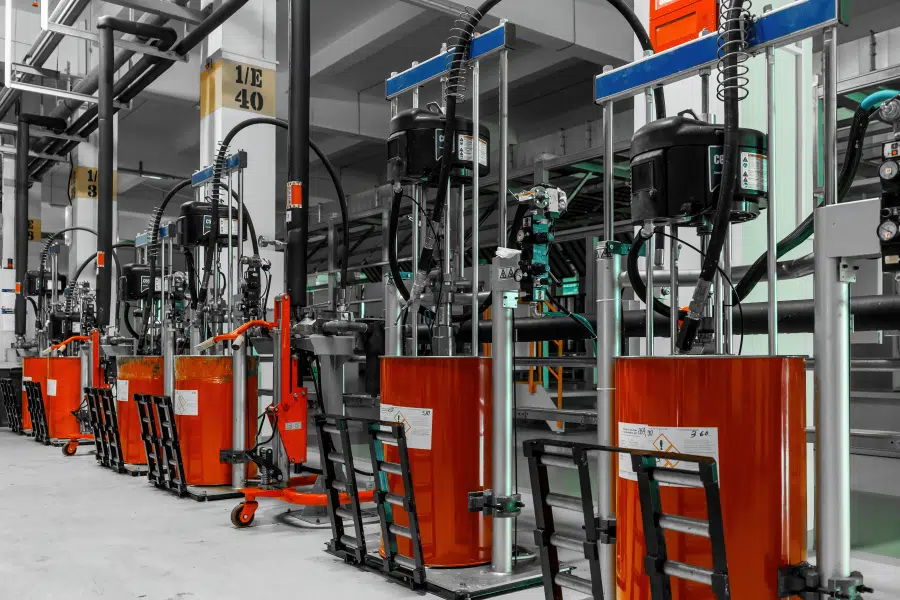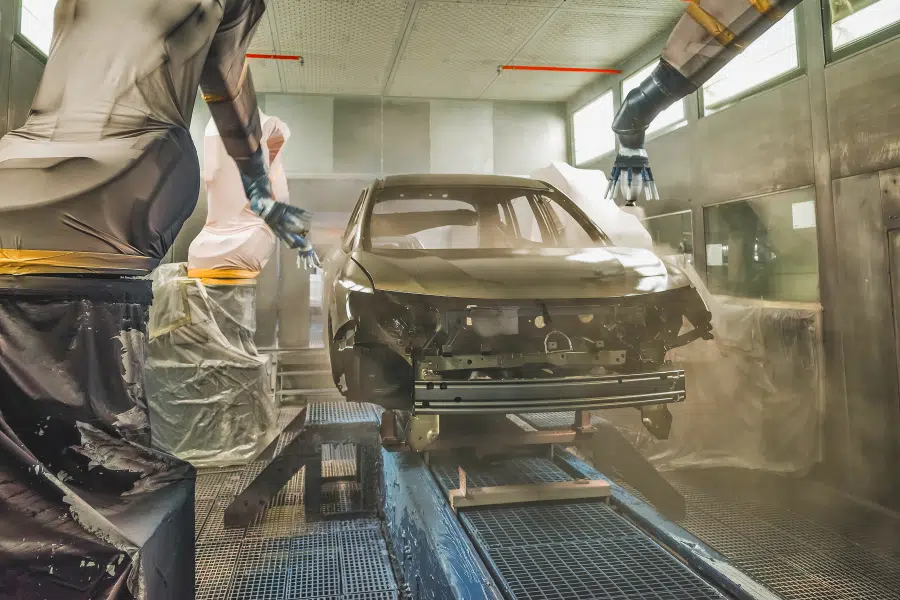Paint shop lines
Surface treatment and coating of car bodies and add-on parts
Primer and undercoat
Dip coating, specifically KTL, forms the robust, comprehensive corrosion protection primer for the car body and is the basis of the coating process chain. The car bodies are transported using robust SKID Conveying Systems. In the KLT bath, the BIW car body is immersed in water-based binders. Special SKID modules are used here. With WinMOD-SIMLINE, you can simulate these dip SKID processes realistically in a virtual environment. This includes the SKID's own rotation and swivel mechanisms and data communication. Contour-accurate sensor monitoring, loading and unloading processes, and object collisions are also simulated in real time.
The 3D CAD data of the SKIDs and car bodies serve as a basis, whereby the WinMOD-SIMLINE SKID library also provides a number of typical car bodies in various stages of development in case no CAD data is available for the VC.
In addition to transport behaviour, you can also simulate fluid and temperature-related processes such as baking ovens or paint recovery. Extensive WinMOD libraries with virtual pumps, valves, tanks and heating elements are available for this purpose.


Top coating with robots
Just like with the base coat, the paint supply, known as the „paint kitchen“, is a central process involving circulation, dosing and rinsing. However, the booth air conditioning, positive and negative pressure zones, temperature and humidity control, and dust management are also regulated by system controls. All these processes can be simulated in real time with WinMOD-SIMLINE. Here, you can again utilize the virtual devices from the WinMOD libraries to simulate circuits and control systems accurately.
The second key aspect is painting robots. Many robot manufacturers offer their own simulation software that allows one or more robots to be run using the original code. With our WinMOD Co-Simulation concept, we offer online connections to these tools for exchanging axis data and communication signals in real time.
The final virtual plant then consists of the 3D robots, the 3D SKID or Power-and-Free conveyor technology for body transport and the associated drive technology. With this WinMOD-SIMLINE painting plant, you can test your automation system and robot sequences, determine throughput (bodies/hour) and cycle time per zone, as well as colour change times.
Further automotive engineering solutions
Production area in which structural body parts and outer skin parts are produced from sheet metal coils or cut-to-size blanks (blanks) by cold or hot forming – from the raw blank to the ready-to-install formed part.
Assembles stamped/formed sheet metal parts, extruded and cast components into a dimensionally accurate body structure – with defined geometry, rigidity, crash and NVH performance as the basis for the paint shop and final assembly.
Highly automated plant chains for surface pre-treatment, coating and curing of car bodies and add-on parts – designed for high throughput, reproducible appearance and corrosion protection.
Pre-assembly of front/rear axle modules as carriers for chassis, steering and drive units such as combustion engines, powertrains or electric axles. Transport to the sequenced handover to the „marriage“ with the body.
Highly automated process chain for the fabrication of traction batteries – from electrode production to cell assembly and forming to module/pack assembly
This area of technology encompasses conveyor systems that transport and sort pallets and mesh boxes containing automotive components. The conveyor elements are large roller and chain conveyors combined with lifting, rotating and shifting tables.
Fully automated high-bay warehouses, which are operated by light or heavy-duty storage and retrieval machines and controlled by distributed automation systems. Warehouse management systems generate the orders for storing and retrieving raw components or complete car bodies.
Ground-based conveyor technology in which car bodies or heavy modules are transported on standardised SKIDs (steel frames with vehicle-specific support points) through assembly, paint shop and buffer areas.
Overhead conveyor systems with electrically driven, individually controllable trolleys on monorail tracks for low or high loads (up to tonnes).
Ground-based conveyor technology in which car bodies or heavy assemblies are moved on platforms along rails. The drive is typically provided by friction wheels, push chain conveyors or push beams, which continuously push the SKIDs forward.